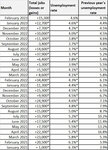


OLYMPIA – Washington’s economy gained an estimated 15,300 jobs (seasonally adjusted) in February. Job growth was highest in the following industries: professional and business services, education and health services, government, leisure and hospitality, and information.
Washington’s monthly unemployment rate remained constant at 4.6% in February. "The downward slide in hiring momentum that emerged late last year has stabilized,” said Employment Security Department (ESD) State Economist Paul Turek. "Payroll employment growth over the fourth quarter has been revised upward and strong job gains occurred these past two months.” Visit ESD’s website to view the entire Monthly Employment Report for February.
ESD paid unemployment insurance benefits to 58,762 people in February, a decrease of 1,895 paid claims over the previous month. Decreases in paid claims within agriculture and accommodation and food services contributed to the overall decrease in paid claims over the month.
The national unemployment rate increased in February from 3.4% to 3.6%. For comparison, the national unemployment rate (revised) for February 2022 was 3.8%.
Updated state preliminary data for January 2023
The preliminary estimated gain of 10,800 jobs for January 2023 was revised upwards to a gain of 12,700 jobs. The seasonally adjusted monthly unemployment rate was confirmed at 4.6%.
Labor force expands again in February
The state’s labor force in February numbered 4,036,300 – an increase of 13,400 people from the previous month. In the Seattle/Bellevue/Everett region, the labor force increased by 1,800 over the same period.
Labor force is defined as the total number of people, both employed and unemployed, over the age of 16. Layoffs and labor force participation are not necessarily connected. When people are laid off but still seeking work, they remain a part of the labor force. A drop in the labor force means people have left work and haven't been actively seeking employment for more than four weeks.
From February 2022 to February 2023, the state’s labor force increased by 54,500, while the Seattle/Bellevue/Everett region increased by 38,000.
From January to February, the number of people who were unemployed statewide increased from 184,400 to 186,200. In the Seattle/Bellevue/Everett region, the number of people who were unemployed decreased from 56,900 to 55,000 over the same period.
Private sector employment increased by 12,600 jobs while government employment increased by 2,700 jobs.
Of the industry sectors, in February: 10 expanded, three contracted. The professional and business services industry had the largest increase (+4,600) in jobs in February, compared with average monthly gains of 2,400 jobs over the prior six months. Within the industry, employment continued to trend up primarily in professional, scientific and technical services (+1,600) and in administrative & support services (+1,900).
The education and health services sector had the second largest increase (+4,500) in jobs in February. Within the industry, employment increased in health services and social assistance (+2,900) and in education services (+1,600).
Annual employment growth strong but moderating. Washington gained an estimated 125,000 jobs from February 2022 to February 2023, not seasonally adjusted. Private sector employment rose by 3.7%, up an estimated 106,700 jobs, while public sector employment rose by 3.3% — up an estimated 18,300 jobs.
From February 2022 – February 2023, 11 major industry sectors expanded and two contracted. The three industry sectors with the largest employment gains year over year, not seasonally adjusted, were: Leisure and hospitality, up 25,600 jobs. Professional and business services, up 25,400 jobs. Education and health services, up 21,700 jobs. The industry sector with the largest employment losses year over year was retail trade, down 1,400 jobs.
Additional observations: The labor force increased in February for the second straight month. This reverses a string of six straight months of labor force contraction during the second half of 2022. Most of the increase in the labor force in February was primarily due to an increase in workers gaining employment. In January, most of the increase in the labor force was due to a rise in the number of individuals classified as unemployed. The unemployment rate, though unchanged in February, rose to 4.6% from a historic low of 3.7% in September 2022. Although the number of job openings throughout the state are down from their peak, the labor market remains tighter than it was before the pandemic. There are still more total job openings than there are unemployed job seekers.
U-6 unemployment rate
The U.S. Bureau of Labor Statistics (BLS) updated its “alternative measures of labor underutilization” for states to include annual averages for 2021. One such alternative measure is the U-6 rate, which considers not only the unemployed population in the official “U-3” unemployment rate, but also marginally attached workers and those employed part time for economic reasons. The U-6 rate is defined by BLS as the “total unemployed, plus all marginally attached workers, plus total employed part time for economic reasons, as a percent of the civilian labor force plus all marginally attached workers.” This U-6 measure measures the “unemployed, underemployed, and those who are not looking but who want a job.” The U-6 annual average unemployment rate for the four-quarter 2022 period for Washington state was 7.5%. This was lower compared to the 10.1% average annual U-6 unemployment rate for 2021. The U.S. U-6 average annual unemployment rate for 2022 was 6.9%.
Comments
No comments on this item Please log in to comment by clicking here